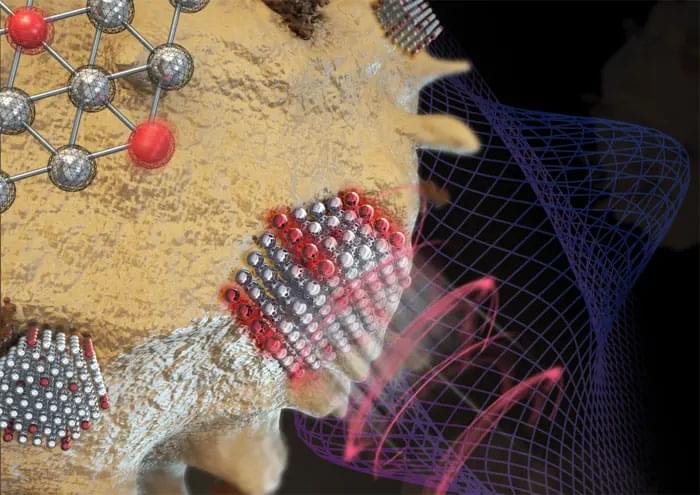Scientists are using bovine genes to produce cow-free milk with original taste and nutrition:
Engineers are using bovine genes in yeasts and plants to create cow-free milk with the same taste and nutrition.
Scientists are using bovine genes to produce cow-free milk with original taste and nutrition:
Engineers are using bovine genes in yeasts and plants to create cow-free milk with the same taste and nutrition.


A series of advances in materials and design have enabled manufacturers to work at scales smaller than a billionth of a size to create devices and objects of nanoscopic dimensions. This is nanotechnology, which, although relatively new, produces materials and technologies already used in mass production.
The European Commission defines nano as any material that is at least 50% composed of particles between one and one hundred nanometers in size (i.e. one billionth of a meter, or one-millionth of a millimeter). Nanomaterials differ from conventional materials because of their unique properties such as higher electrical conductivity and mechanical strength, sensor technologies, and biomedical applications, and because they can create coatings that make surfaces more hydrophobic or self-cleaning.
The widespread use of nanotechnology is relatively new. Since 2000, nanomaterials have been used industrially as new research and experimental designs have made their effectiveness in different sectors clear. For example, in the health field, nanotechnology helps to reduce diagnostic errors and to develop nanobots (microscale robots) to repair and replace intercellular structures, or repair DNA molecules; in the chemical sector, it facilitates coating devices with nanoparticles to improve their smoothness and heat resistance; in manufacturing, materials developed with nanotechnology enhance the performance of the final product by improving heat resistance, strength, durability, and electrical conductivity.

Groundbreaking research has revealed a new way to measure incredibly minute forces at the nanoscale in water, pushing the boundaries of what scientists know about the microscopic world.
The significant nanotechnology advance was achieved by researchers from Beihang University in China with RMIT University and other leading institutions including the Australian National University and University of Technology Sydney (Nature Photonics, “Sub-femtonewton force sensing in solution by super-resolved photonic force microscopy”).
The new technique, involving a super-resolved photonic force microscope (SRPFM), is capable of detecting forces in water as small as 108.2 attonewtons – a scale so minute that it compares to measuring the weight of a virus.

Imagine a close basketball game that comes down to the final shot. The probability of the ball going through the hoop might be fairly low, but it would dramatically increase if the player were afforded the opportunity to shoot it over and over.
A similar idea is at play in the scientific field of membrane separations, a key process central to industries that include everything from biotechnology to petrochemicals to water treatment to food and beverage.
“Separations lie at the heart of so many of the products we use in our everyday lives,” said Seth Darling, head of the Advanced Materials for Energy Water Systems (AMEWS) Center at the U.S. Department of Energy’s (DOE) Argonne National Laboratory. “Membranes are the key to achieving efficient separations.”

As one of the Department of Defense’s 14 critical technology areas, artificial intelligence has taken center stage in the organization’s research and development endeavors.
According to Matt Turek, deputy director of the Defense Advanced Research Projects Agency’s Information Innovation Office, approximately 70 percent of the agency’s programs now use AI and machine learning. Its priorities are not just to develop systems for U.S. warfighters, but to prevent “strategic surprise” from adversary AI systems.

In the race to develop practical quantum computers, a team of researchers has achieved a significant milestone by demonstrating a new method for manipulating quantum information. This breakthrough, published in the journal Nature Communications, could lead to faster and more efficient quantum computing by harnessing the power of customizable “nonlinearities” in superconducting circuits.
Quantum computers promise to revolutionize computing by leveraging the principles of quantum mechanics to perform complex calculations that are impossible for classical computers. However, one of the main challenges in building quantum computers is the difficulty in manipulating and controlling quantum information, known as qubits.
The researchers, led by Axel M. Eriksson and Simone Gasparinetti from Chalmers University of Technology in Sweden, have developed a novel approach that allows for greater control over qubits by using a special type of superconducting circuit called a SNAIL (Superconducting Nonlinear Asymmetric Inductive eLement) resonator.
Researchers have created a new class of materials called “glassy gels” that are as hard as glassy polymers, but – if you apply enough force – can stretch up to five times their original length, rather than breaking. A key thing that distinguishes glassy gels is that they are more than 50% liquid, which makes them more efficient conductors of electricity than common plastics that have comparable physical characteristics. Credit: Meixiang Wang, NC State University.
Researchers have developed a new class of materials known as glassy gels, which combine the hardness of glassy polymers with the stretchability of gels.
These materials maintain over 50% liquid content, enhancing their elasticity and adhesive properties. The fabrication process involves mixing polymer precursors with an ionic liquid and curing with ultraviolet light, allowing for easy production and potential for widespread application in industries like electronics and medical devices.

Short clip about perceptron research done in the 1950’s and 1960’s.